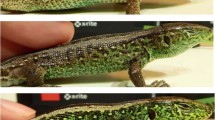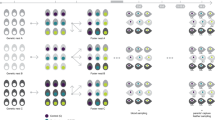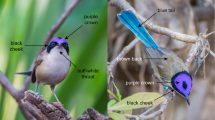Abstract
THE idea that female birds choose mates on the basis of genetic quality is a contentious issue in sexual selection1,2 because empirical evidence is lacking3,4. Females mating with attractive males may obtain direct benefits such as high quality parental4–6 or breeding resources7, or indirect benefits such as offspring of high genotypic quality8–11. This debate could be resolved if the traits associated with attractiveness in males have a high heritability, and correlate with the viability of their offspring. Here I report the results of a cross-fostering experiment in great tits in which parents raised unrelated young. This showed that the plumage trait associated with attractiveness in males was heritable, and that the viability of male offspring was correlated with the plumage traits of their putative father. These results show that females mating with attractive male great tits realize an indirect fitness advantage.
This is a preview of subscription content, access via your institution
Access options
Subscribe to this journal
Receive 51 print issues and online access
$199.00 per year
only $3.90 per issue
Buy this article
- Purchase on Springer Link
- Instant access to full article PDF
Prices may be subject to local taxes which are calculated during checkout
Similar content being viewed by others
References
Kirkpatrick, M. & Ryan, M. Nature 350, 33–38 (1991).
Harvey, P. H. & Bradbury, J. W. in Behavioural Ecology: An Evolutionary Approach (eds Krebs, J. R. & Davies, N. B.) 203–233 (Blackwell, Oxford, 1991)
Mõller, A. P. Evolution 44, 771–784 (1990).
Hill, G. E. Nature 350, 337–339 (1991).
Hoelzer, G. A. Anim. Behav. 38, 1067–1078 (1989).
Norris, K. J. Behavl Ecol. Sociobiol. 27, 275–281 (1990).
Alatalo, R. V., Lunberg, A. & Glynn, C. Nature 323, 152–153 (1986).
Trivers, R. L. Sexual Selection and the Descent of Man (ed. Campbell, B.) (Aldine, Chicago, 1972).
Zahavi, A. J. theor. Biol. 53, 205–214 (1975).
Hamilton, W. D. & Zuk, M. Science 218, 384–387 (1982).
Andersson, M. B. Evolution 40, 804–816 (1986).
Perrins, C. M. British Tits (Collins, London, 1979).
Maynard-Smith, J. & Harper, D. C. G. Phil. Trans. R. Soc. B319, 557–570 (1988).
Wilson, J. D. Anim. Behav. 43, 99–1009 (1992).
Norris, K. J. Behavl Ecol. Sociobiol. 26, 129–138 (1990).
Falconer, D. S. Introduction to Quantitative Genetics 3rd edn (Longman, Harlow, 1989).
Svensson, L. Identification Guide to European Passerines (Published privately, Stockholm, 1984).
Clobert, J., Perrins, C. M., McCleery, R. H. & Gosler, A. G. J. anim. Ecol. 57, 287–306 (1988).
Greenwood, P. J., Harvey, P. H. & Perrins, C. M. J. anim. Ecol. 48, 123–142 (1979).
Mõller, A. P. J. evol. Biol. 2, 125–140 (1989).
Mõller, A. P. Evolution 45, 1823–1836 (1991).
Eshel, I. & Hamilton, W. D. Proc. R. Soc. B222, 1–14 (1984).
Iwasa, Y., Pomiankowski, A. & Nee, S. Evolution 45, 1431–1442 (1991).
Author information
Authors and Affiliations
Rights and permissions
About this article
Cite this article
Norris, K. Heritable variation in a plumage indicator of viability in male great tits Parus major. Nature 362, 537–539 (1993). https://doi.org/10.1038/362537a0
Received:
Accepted:
Issue Date:
DOI: https://doi.org/10.1038/362537a0
This article is cited by
-
Structural equation modeling of female gait attractiveness using gait kinematics
Scientific Reports (2023)
-
Male’s age and plumage coloration predicts brood sex ratio in the Common Kingfisher (Alcedo atthis)
Journal of Ornithology (2023)
-
Relationships between male secondary sexual traits, physiological state and offspring viability in the three-spined stickleback
BMC Ecology and Evolution (2022)
-
Male genital lobe morphology affects the chance to copulate in Drosophila pachea
BMC Ecology and Evolution (2021)
-
Does the tie fit the female? Melanin-based colouration, aggressive personality and reproductive investment in female great tits (Parus major)
Behavioral Ecology and Sociobiology (2020)
Comments
By submitting a comment you agree to abide by our Terms and Community Guidelines. If you find something abusive or that does not comply with our terms or guidelines please flag it as inappropriate.



